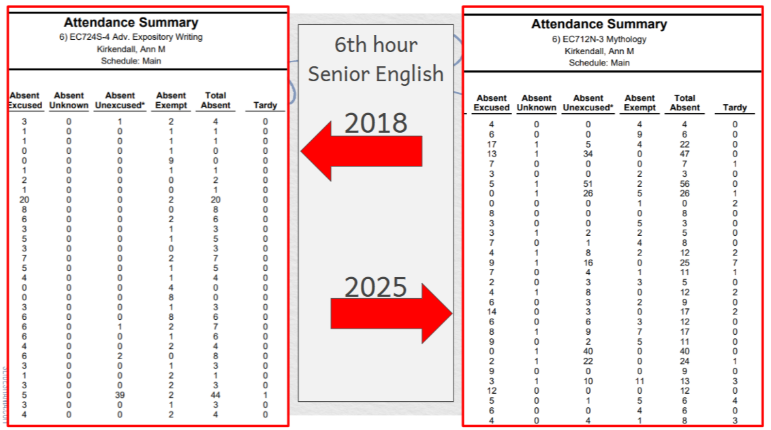Every day at lunch, a group of girls near my lunch table sit with their closest friends. They enjoy two or three minutes of animated conversation. After one member picks up her phone, soon the rest follow. Engrossed in their phones, they seem to forget about each other for the remainder of lunch.
A glance around the cafeteria at West Ottawa High School reveals minimal communication. Yet, this lack of conversation usually goes unnoticed. Teenagers at West Ottawa have become accustomed to it.
During lunch at Forest Hills High School, however, one would see real face-to-face conversations in the cafeteria.
Forest Hills Northern student Owen Strobel said, “I notice it a lot at lunch where kids are talking way more and having actual conversations.”
The difference between Forest Hills and West Ottawa students is not that Forest Hills students are less addicted to their phones. The difference is Forest Hills’ administrators recognized the addiction, how negatively it affects its students, and they took action.
This year Forest Hills established a new policy regarding cell phone use.
The Forest Hills student handbook states that “Students will not be allowed to carry or use cell phones during the school day.”
No cell phones in the school, period. The handbook explains the consequences of violating this policy.
On the student’s first offense, the student may pick up the phone from an administrator at the end of the day. The second offense results in the student’s parents needing to pick up the phone. The third offense results in a phone contract (check-in/checkout of the phone for the remainder of the semester) and thirty days of social probation of any extracurricular school functions.
Forest Hills installed these strict rules to ensure that students would follow the policy. Failure to do so ultimately could result in suspension from school.
At West Ottawa High School, the handbook states that “Cell phones and personal media devices (iPods, MP3 players, video games, etc.) may be used on the campus, but are prohibited from being used in the classroom setting unless deemed educationally appropriate by the teacher.”
Although some West Ottawa teachers implement their own policies, the majority of teachers allow students to have their phones out in class.
Most of West Ottawa’s staff agrees that West Ottawa needs a stricter phone policy.
In a recent poll of 65 West Ottawa High School staff members, the staff was presented with the policy at Forest Hills and asked if a similar policy should be implemented at West Ottawa. Nearly 80% responded yes, a phone policy similar to Forest Hills’ should be implemented.
Many of the West Ottawa teachers view phones as the number one distraction in the classroom.
Instructor Amy Jo Burmeister said, “It [the phone] is the single most common disruption in the classroom; well above all other disruptions. I have to remind students every single hour to follow the policy about removing earbuds, turning off music, putting phones away, etc. Banning phones altogether would save a lot of instructional time.”
West Ottawa teachers that have a phone policy implemented in their classrooms find this to be true.
Instructor Nicole Walworth enforced a strict no-phone policy this year. If Walworth sees a phone, she writes a referral. Walworth believes that her policy has been effective. “I think it has kind of eliminated the distraction of students having their phones near them because they don’t have immediate access to it; it’s not in their pocket and they just seem less distracted.”
Sr. Thomas Emery, a student in Walworth’s first-hour class, said, “Unlike my math classes in the past, I usually can finish almost all of my homework in class. The amount of work I get done has definitely increased because of the policy in her room.”
West Ottawa teachers also believe that banning phones would decrease drama that stems from social media and increase social interactions.
Burmeister said, “Social media drama is fueled during the school day because of student access to technology. Banning phones would again reduce a LOT of social media drama during the school day and help keep students engaged in the lesson or activity.”
Instructor Brent Wyckoff also believes there has been a decrease in the social interactions between students because of phones, resulting in students lacking basic communication skills.
Wyckoff said, “I would argue that more students are not very skilled at face-to-face interaction, which I think is a problem, especially as you have to go into the job market and do a face-to-face interview.”
This decrease in communication skills is because students do most of their communicating through their phones. Wycoff argues that if phones were removed from school, there would be more face-to-face interactions. With more face-to-face interactions, students would develop better social skills.
Disagreeing with implementing a no-phone policy, 21.5% of West Ottawa High School staff make strong points.
In the West Ottawa survey, five different teachers argued that instead of banning phones, the staff should instead instruct students on the proper use of them. These staff members claimed that banning phones does not prepare students for the real world where students will have to properly utilize technology in their daily lives.
In addition, West Ottawa students generally are hesitant to agree with a no-phone policy because they worry about not being able to contact their parents when they need to.
Jr. Sophie Walsh said “I have to contact my parents practically every day because of a change in my schedule. I really don’t know how I would function without being able to do that.”
Before the policy at Forest Hills was installed, Forest Hills students and staff had similar worries.
However, three months into the school year, the Forest Hills staff and students support the policy and firmly believe the policy is effective.
The main benefit of the policy is that students are less distracted in the classroom.
Forest Hills Eastern Campus safety officer Ty Starling believes that the students have realized how much work they can achieve in the classroom.
Starling said, “I have to believe that change is a struggle for most of us, but after the first few weeks of school students have bought into the no-phone policy. Students have begun to realize how many less distractions occur hourly in the classroom.”
Forest Hills Central counselor Jodi Arsulowicz said, “I think the policy has been effective in reducing the many distractions from cell phone use.”
Students at Forest Hills agree that the policy has helped learning in the classroom.
Forest Hills Northern student Maddy Hargrave said, “It feels like we’re all paying attention and not distracted by conversations or social media.”
Students also agree that social interaction has increased. As mentioned earlier, one place Strobel believes this increase is clear is the lunchroom.
Strobel said, “In the lunchroom last year when the policy was not put in place, kids were more focused on their phones than anyone around them; there was still conversation but it was minimal. And now with the policy again there is way more interaction between kids.”
Strobel also believes that the policy has helped his mental state.
Strobel said, “Being able to take a break from the phones is very nice especially since everyone around you is taking a break from them too; that makes it a much easier and better thing to do.”
Hargrave agrees, “I feel like it’s improved my mental state because there isn’t the constant feeling that someone is recording you.”
Forest Hills Eastern counselor Mitchell Blink confirms students’ comments about a decrease in issues related to social media. Blink said “Since this policy has been put into action, we’ve seen a decrease in problem behaviors, both disciplinary and social/emotional. Students are engaging with each other more, and I believe there has also been a decrease in the amount of anxiety issues related to social media, texting, etc. related to phone use.”
The three main benefits of the policy appear to be fewer distractions in the classroom, more peer-to-peer interactions, and an improved mental state of students.
Despite these benefits, students did admit one minor inconvenience to the policy. The main problem students have with the policy is not being able to text their parents throughout the day.
Forest Hills Northern student Paige Lebster said, “When we got dismissed early I couldn’t text my mom so I got out of school really late.”
However, students can still contact their parents if necessary and it hasn’t necessarily been a problem, rather a small frustration.
Strobel said, “Almost all of the teachers if you ask will let you use the phone or go to the office right away.”
The attendance secretary at Forest Hills Eastern, Mary Jo Pomeroy, believes that the policy hasn’t created too much of a problem with parents being able to reach students.
Pomeroy said, “We have a few more parents calling the office to give students messages but it has not been excessive. It has been pretty seamless.”
Addressing the argument that banning phones fails to prepare students for the real world, Starling believes the opposite. “I truly believe the cell phone policy will prepare our high schoolers for life…how many times are we distracted in meetings, concerts, funerals, church, etc. where phones cause interruptions. In my opinion training students to be respectful of organized events, classroom learning time (that don’t need to have cellular interruptions) can allow our youth to be more respectful/courteous/mindful of others. This perspective alone (in my opinion) prepares are youth for being better, caring human beings.”
The three-month-old policy at Forest Hills seems to be working. Nearly 80% of the West Ottawa staff would like to follow their lead.







